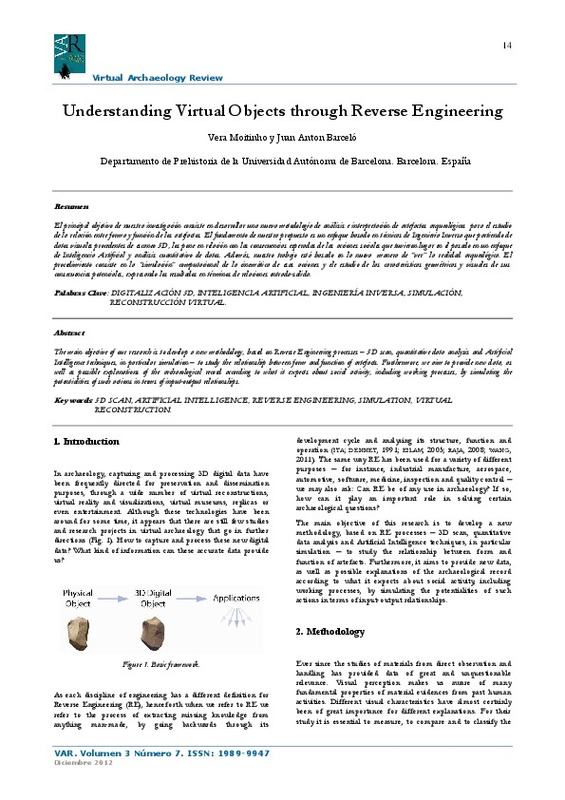BARCELO, J. A. (2010): "Visual Analysis in Archaeology. An Artificial Intelligence Approach", in Morphometrics for Nonmorphometricians, edited by E.M.T. Elewa. Springer.
http://dx.doi.org/10.1007/978-3-540-95853-6_5
BATHOW, Christiane and WACHOWIAK, Mel (2008): "3D Scanning in Truly Remote Areas", in Coordinate Metrology Systems Conference - CMSC, Charlotte, NC. http://www.accurexmeasure.com/applicationpages/3d%20scanning%20in%20remote%20areas.pdf [View: 24-03-2011].
[+]
BARCELO, J. A. (2010): "Visual Analysis in Archaeology. An Artificial Intelligence Approach", in Morphometrics for Nonmorphometricians, edited by E.M.T. Elewa. Springer.
http://dx.doi.org/10.1007/978-3-540-95853-6_5
BATHOW, Christiane and WACHOWIAK, Mel (2008): "3D Scanning in Truly Remote Areas", in Coordinate Metrology Systems Conference - CMSC, Charlotte, NC. http://www.accurexmeasure.com/applicationpages/3d%20scanning%20in%20remote%20areas.pdf [View: 24-03-2011].
BERALDIN, J.-A. (2004): "Integration of Laser Scanning and Close-range Photogrammetry - The last Decade and Beyond". http://www.isprs.org/proceedings/XXXV/congress/comm5/papers/188.pdf [View: 24-03-2011].
DENNET, Daniel (1991): "Cognitive Science as Reverse Engineering: Several Meanings of 'Top-Down' and 'Bottom-Up'", final draft for Proceedings of the 9th International Congress of Logic, Methodology and Philosophy of Science. http://users.ecs.soton.ac.uk/harnad/Papers/Py104/dennett.eng.html [View: 24-03-2011].
EILAM, Eldad (2005): Reversing: Secrets of Reverse Engineering. Wiley Publishing, Indianapolis.
GEORGOPOULOS, Andreas et al. (2010): "Assessing the Performance of a Structured Light Scanner", in Commission V Symposium. International Archives of Photogrammetry, Remote Sensing and Spatial Information Sciences, 38(5). http://www.isprs.org/proceedings/XXXVIII/part5/papers/177.pdf [View: 24-03-2011].
KAMAT, V. R. and MARTINEZ, J. C. (2007): "Variable-speed object motion in 3D visualizations of discrete-event construction simulation models". ITcon, Vol. 12, pp. 293-303, http://www.itcon.org/2007/20 [View: 24-03-2011].
MARA, Hubert et al. (2004): "The Uniformity of Wheel Produced Pottery Deduced from 3D Image Processing and Scanning", in Proceedings of the 28th Workshop of the Austrian Association for Pattern Recognition - OAGM/AAPR, Digital Imaging in Media and Education. W. Burger, J. Scharinger (ed.). Schriftenreihe der OCG, no 179, pp. 197-204.
MOITINHO, Vera (2007): "Virtual Archaeology: Work in Progress", in Proceedings of the 35th Computer Applications and Quantitative Methods in Archaeology Congress, CAA 2007.
PERROS, Harry (2009): "Computer Simulation Techniques: The definitive introduction!". Computer Science Department - NC State University, Raleigh, NC. http://www4.ncsu.edu/~hp/simulation.pdf [View: 24-03-2011].
RAJA, Vinesh and FERNANDES, K. J. (ed.) (2008): Reverse Engineering: An Industrial Perspective. Springer-Verlag, London.
REICHENBACH, Tomislav and KOVAČIĆ, Zdenko (2003): "Derivation of Kinematic Parameters from a 3D Robot Model Used for Collision-free Path Planning", in Proceedings of the 11th Mediterranean Conference on Control and Automation, MED '03. http://med.ee.nd.edu/MED11/pdf/papers/t2-039.pdf [View: 24-03-2011].
USAIT: "Glossary", in U. S. Army Information Technology Agency, http://ita.army.mil/CatalogService.aspx?service_Id=122&serviceGroup_Id=9 [View: 24-03-2011].
WANG, Wego (2011): Reverse Engineering: Technology of Reinvention. CRC Press.
[-]








